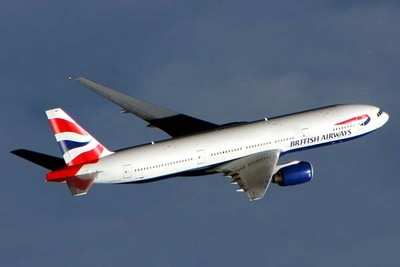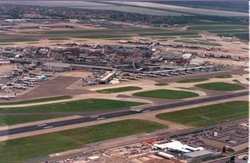Says Engines Did Not Respond To Throttle-Up Commands
 Below is the unedited, initial
textual report on the January 17 accident involving a British
Airways Boeing 777-200. As ANN reported, the
aircraft, inbound from Beijing, touched down short of the runway at
London's Heathrow Airport, skidding to a violent stop that,
fortunately, only resulted in some minor injuries to those
onboard.
Below is the unedited, initial
textual report on the January 17 accident involving a British
Airways Boeing 777-200. As ANN reported, the
aircraft, inbound from Beijing, touched down short of the runway at
London's Heathrow Airport, skidding to a violent stop that,
fortunately, only resulted in some minor injuries to those
onboard.
Early theories regarding potential reasons why the
Rolls-Royce Trent-powered airliner apparently lost power on
approach were varied, with some obviously more credible than
others.
In their initial report released Sunday, officials with the
UK Air Accidents Investigation Branch AAIB) confirm the plane's
engines failed to respond to throttle inputs from the cockpit --
first from the plane's autopilot, then manual inputs from the
plane's flight crew.
What caused that potentially catastrophic scenario, however,
has not yet been determined -- Ed.
Following an uneventful flight from Beijing, China, the aircraft
was established on an ILS approach to Runway 27L at London
Heathrow. Initially the approach progressed normally, with the
Autopilot and Autothrottle engaged, until the aircraft was at a
height of approximately 600 ft and 2 miles from touch down. The
aircraft then descended rapidly and struck the ground, some 1,000
ft short of the paved runway surface, just inside the airfield
boundary fence. The aircraft stopped on the very beginning of the
paved surface of Runway 27L. During the short ground roll the right
main landing gear separated from the wing and the left main landing
gear was pushed up through the wing root. A significant amount of
fuel leaked from the aircraft but there was no fire. An emergency
evacuation via the slides was supervised by the cabin crew and all
occupants left the aircraft, some receiving minor injuries.

The AAIB was notified of the accident within a few minutes and a
team of Inspectors including engineers, pilots and a flight
recorder specialist deployed to Heathrow. In accordance with the
established international arrangements the National Transportation
Safety Board (NTSB) of the USA, representing the State of Design
and Manufacture of the aircraft, was informed of the event. The
NTSB appointed an Accredited Representative to lead a team from the
USA made up of investigators from the NTSB, the FAA and Boeing. A
Boeing investigator already in the UK joined the investigation on
the evening of the event, the remainder of the team arrived in the
UK on Friday 18th January. Rolls-Royce, the engine manufacturer is
also supporting the investigation, an investigator having joined
the AAIB team.
Activity at the accident scene was coordinated with the Airport
Fire and Rescue Service, the Police, the British Airports Authority
and British Airways to ensure the recovery of all relevant
evidence, to facilitate the removal of the aircraft and the
reinstatement of airport operations.
 The flight crew were interviewed on
the evening of the event by an AAIB Operations Inspector and the
Flight Data Recorder (FDR), Cockpit Voice Recorder (CVR) and Quick
Access Recorder (QAR) were removed for replay. The CVR and FDR have
been successfully downloaded at the AAIB laboratories at
Farnborough and both records cover the critical final stages of the
flight. The QAR was downloaded with the assistance of British
Airways and the equipment manufacturer. All of the downloaded
information is now the subject of detailed analysis.
The flight crew were interviewed on
the evening of the event by an AAIB Operations Inspector and the
Flight Data Recorder (FDR), Cockpit Voice Recorder (CVR) and Quick
Access Recorder (QAR) were removed for replay. The CVR and FDR have
been successfully downloaded at the AAIB laboratories at
Farnborough and both records cover the critical final stages of the
flight. The QAR was downloaded with the assistance of British
Airways and the equipment manufacturer. All of the downloaded
information is now the subject of detailed analysis.
Examination of the aircraft systems and engines is ongoing.
Initial indications from the interviews and Flight Recorder
analyses show the flight and approach to have progressed normally
until the aircraft was established on late finals for Runway 27L.
At approximately 600 ft and 2 miles from touch down, the
Autothrottle demanded an increase in thrust from the two engines
but the engines did not respond. Following further demands for
increased thrust from the Autothrottle, and subsequently the flight
crew moving the throttle levers, the engines similarly failed to
respond. The aircraft speed reduced and the aircraft descended onto
the grass short of the paved runway surface.
The investigation is now focussed on more detailed analysis of
the Flight Recorder information, collecting further recorded
information from various system modules and examining the range of
aircraft systems that could influence engine operation.
 Aero-News: Quote of the Day (12.11.25)
Aero-News: Quote of the Day (12.11.25) ANN's Daily Aero-Term (12.11.25): Nonradar Arrival
ANN's Daily Aero-Term (12.11.25): Nonradar Arrival Classic Aero-TV: David Uhl and the Lofty Art of Aircraft Portraiture
Classic Aero-TV: David Uhl and the Lofty Art of Aircraft Portraiture Airborne-NextGen 12.09.25: Amazon Crash, China Rocket Accident, UAV Black Hawk
Airborne-NextGen 12.09.25: Amazon Crash, China Rocket Accident, UAV Black Hawk Airborne 12.05.25: Thunderbird Ejects, Lost Air india 737, Dynon Update
Airborne 12.05.25: Thunderbird Ejects, Lost Air india 737, Dynon Update





